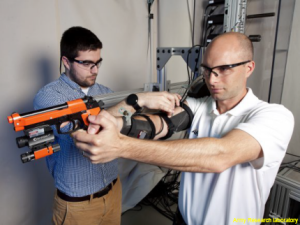 In the not-too-distant future, every U.S. soldier could sport an expert marksman badge, thanks to Mobile Arm Exoskeleton for Firearm Aim Stabilization (MAXFAS), developed at the U.S. Army Research Laboratory in Aberdeen, Maryland.
In the not-too-distant future, every U.S. soldier could sport an expert marksman badge, thanks to Mobile Arm Exoskeleton for Firearm Aim Stabilization (MAXFAS), developed at the U.S. Army Research Laboratory in Aberdeen, Maryland.
The device is still a stationary prototype; however, developers are already looking at ways to make MAXFAS mobile. Similar medical technology exists to help patients control Parkinson’s trembling and relearn to use arms damaged by strokes.
MAXFAS is a 10-ounce, high-tech arm brace equipped with gyroscopes and accelerometers that attaches to a shooter’s forearm. The sensors detect the wearer’s muscle activity, transferring the information to microchips. The chips can differentiate between voluntary and involuntary movement, and compensate for involuntary tics and shaking through the exoskeleton’s cables. The shooter’s arm is more steady, his aim more sure. It’s based on a University of Delaware project from 2013 (PDF).
Boot camp will never be the same.